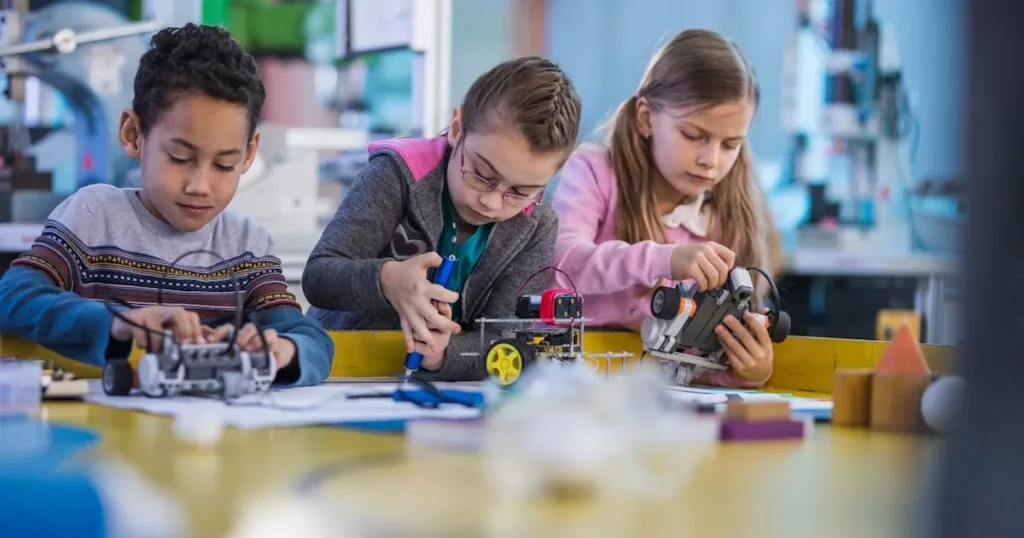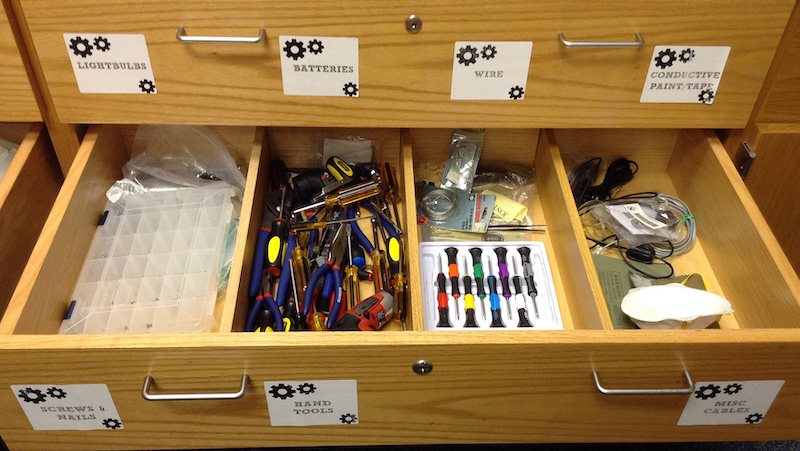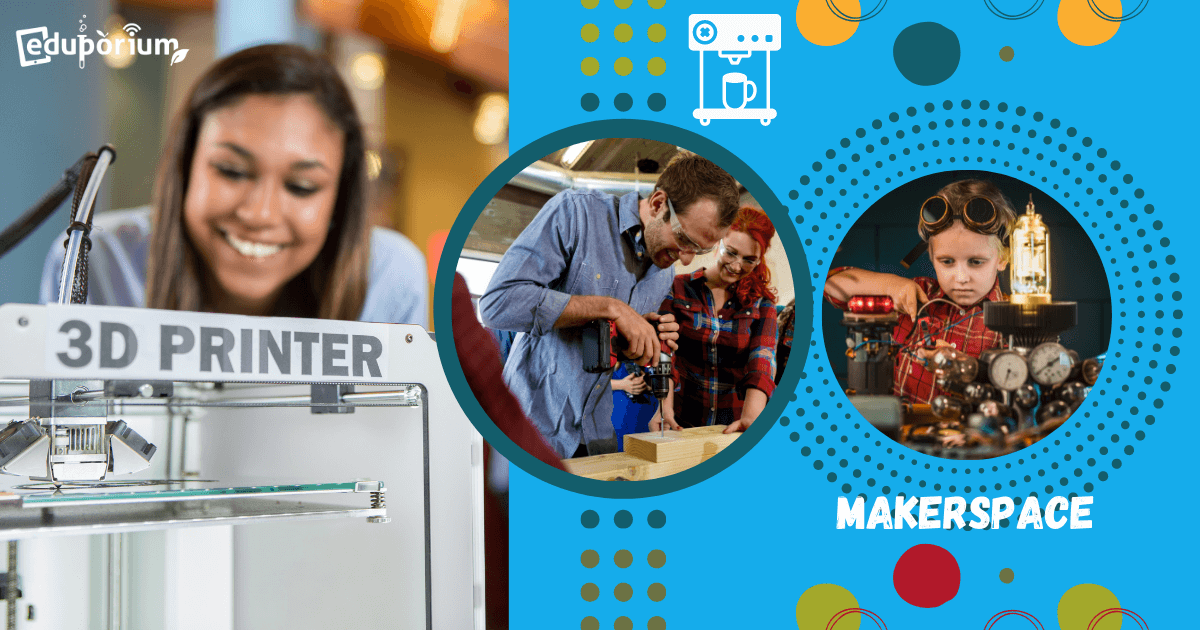At Eduporium, we take pride in providing customized STEM, EdTech, and makerspace solutions to fit with whatever teachers need. We know how some educators spend the majority of their time in their classroom, others are often working in the library, and that there are those who have carved out entirely new roles for themselves in school makerspaces. It is these innovative educators who we might be able to offer the most assistance to. Our MakerEd experts are super well-versed on today's best STEAM and makerspace tools, technologies, smart budget strategies, and design trends—something we’ve actively been focusing on. So, whether you have a makerspace at your school already and are looking to make it better or you need some guidance with getting started, our makerspace team can help you out.
A Personalized Plan
In all our years of working with teachers and school leaders, we’ve never seen two makerspaces that have looked exactly alike or heard two educators describe spaces that are exactly the same. So, when it comes to makerspaces in education, they are somewhat like snowflakes—all totally unique. Every educator has different goals for their makerspace and all different resources available to them for making things happen. What’s essential to one makerspace leader might be something that others have never considered or even needed to think about. That’s why, as part of our makerspace consultation service, we work directly with the educators who will be teaching in the makerspace to learn about their hopes, needs, and resources to craft a personalized plan for success.
Having worked with various school and district leaders nationwide, we understand what it takes to design a successful makerspace. They might have a ton of makerspace ideas, but one key thing for educators to do is to stay true to their learning goals and stay within their space. In creating this personalized plan for you, we’ll take into account everything from budget restraints and the size of the space to how skilled you and your students are when it comes to working with different technologies. If you're interested in getting some techy equipment, like a 3D printer or CNC machine, that’s great! If you’re more interested in finding random craft materials and incorporating some low-tech learning into your makerspace, that'll work, too! Whatever's important to you is important to us.
Every makerspace has a touch of uniqueness to it and that is something we don’t take lightly. Throughout the consultation process, we like to speak directly with teachers (and students, too, if possible) so that we can build a clearer idea of what the space should include. From the initial conversation, during which we'll discuss your needs and goals, to the actual implementation of the MakerEd tools, we’re here to help make sure that launching your makerspace goes as smoothly as possible. Our online store contains hundreds of dynamic and engaging makerspace tools that we recommend to teachers. By learning your goals, we can easily come back with a list (short or long) full of technology tools that'll support the development of those goals. We also make it a point to build on what you already have and help you try new things!
Eduporium Expertise
When we share various makerspace recommendations with teachers, we’re not just trying to make a quick sale. We've done our research on STEAM solutions that work best in today's classrooms. In fact, our team fully vets every single product line on our store to confirm its viability for today’s educational environments, which, as you know, include makerspaces. While there's no limit to the size of our store, we are not willing to just put anything up there. The technologies we recommend and endorse must be easy for teachers at all levels to integrate, easy for both them and children to understand, and actively help teachers advance 21st century learning. We don’t want educators or students struggling with how to use a certain piece of technology and we especially don’t want them left wondering how it helped them learn.
A lot of the time, we use our expertise to recommend one or more STEM tools for educators to use in their makerspace. While this kind of guidance is great because it helps them see what they could be offering for their students or what they might want to stay away from, it’s not the only advice that we provide. Take the layout or placement of a makerspace, for example. An educator might have been given the green light to create the makerspace, but they might have to find the location on their own. And, for some teachers, this means converting an empty classroom or an old closet. Sometimes, however, it might even end up being somewhere else. Whatever leeway or restrictions you have, we can help in every phase of the process.
Since they're found pretty much anywhere in school buildings, one place makerspaces tend to pop up is in the library. This has led to many K-12 school librarians taking on new and exciting roles as the makerspace facilitator. If that is you and you're a bit overwhelmed, we can certainly help to ease your transition. We can help educators with designing and converting the area into a functional makerspace by providing guidance on everything from the types of tables and chairs that will work best to technology that’s small enough but powerful enough to get kids innovating. We know it can be tough when creating a makerspace, especially since educators tend to have so many exciting ideas and a specific vision for how they want it to turn out. And, for that reason, we’re here to help!

Budget Flexibility
One of the main points we’re trying to convey is that no two school makerspaces are the same. In addition to that, there is a pretty good chance that no two school makerspace budgets are exactly the same. We’ve worked with teachers from all different types of schools—private, Title 1, public, inner-city, rural, and so on. From experience, we can definitely say that they pretty much all have their own set of budgetary freedoms and restrictions. And, there is absolutely nothing wrong with that. With schools that feature many different demographics come varying types of budgets. Some are big enough to help these educators accomplish everything they want to do while others are sometimes maybe nonexistent. The point is that makerspace learning isn't defined by the amount of money that’s spent on them.
With that being said, we have experience working with educators who have all sorts of different budgetary requirements and we’ve been able to learn a lot about making their unique needs a reality. Although tough, it's possible to start up makerspaces for free (or at least a very low cost to you). We sometimes hear about educators appealing to student families, asking them to spare any extra supplies and materials from home. This is one way to launch a makerspace for free and it could help teachers acquire reusable materials, like scissors, chairs, tables, yard sticks, and more. It could also help with acquiring the non-reusable materials, however, like cardboard, tape, glue, and you name it. So, if you're thinking about making an attempt at this strategy, remember to keep that in mind.
We’ve seen makerspaces cost only a few thousand dollars and some others top out at over $100,000. The important thing is that spending more money doesn’t always equate to greater success. It’s important that you research technology and develop a vision for what you think will work best for your students. Budgets are big factors in makerspace design, but educators shouldn't feel like their budgets are preventing them from accomplishing objectives. As part of our consultation services, we’ll even meet with educators about their funding needs. If you are applying for a grant for makerspace materials, we also offer our own $500 monthly grant program that’s open to everyone in the education world. Essentially, if you want to launch makerspace opportunities at your school, money shouldn’t make or break its success. If you reach out to us, we’ll help you maximize your dollars and provide valuable input on potential solutions.
High Tech Makerspace Options
High tech tools are awesome in makerspaces because they empower children to design and create almost anything. Low tech tools are also useful, but let’s start off with discussing some of your higher-end options. In terms of technology, when we consider how technologically advanced something is, we might associate it with higher costs. In school makerspaces, the most commonly used high-tech items typically include 3D printers, CNC machines, 3D formers, and laser printers. If you don’t know much about these technologies, you may be misled and believe they’re much too expensive. Fortunately for teachers, these devices won’t necessarily break your bank, especially if you know how to research them, the features you want them to have, and know where you can find alternative options that are more affordable.
In makerspaces, 3D printers are actually very common across various levels of education, offering different levels of power and complexity. There are small, more affordable, and less complex printers that educators can use to introduce students to 3D printing starting in the earlier grades, like any LulzBot 3D printers, for example. As children feel more comfortable with 3D printing and 3D design, the MakerBot printers provide a lot more opportunities with innovative design and engineering. These 3D printers are more expensive, but the power, precision, and reliability are at the top of the list in education. The Glowforge 3D laser printers are also great for use in high school and even college makerspaces. We always hear about students using these 3D printer brands in makerspaces, including one project related to the pandemic we helped with!
Another type of high-tech makerspace tool is a CNC machine. Whereas 3D printers help enable additive manufacturing (creating objects out of designs), CNC machines do the opposite. They're used in creating smaller, more intricate objects out of larger objects. In utilizing these CNC machines, children can develop technical and design skills—even in high school makerspaces. Students can use these types of machines to engineer original creations out of a bunch of different materials. There are many kinds of CNC machines that work well in makerspaces, but we don't offer any at this moment. So, as of now, some top picks for a high-tech makerspace include these 3D printers, vacuum formers, and 3D laser printers, but we're always on the lookout for new tech tools.

Low Tech Makerspace Options
Sure, the high-tech stuff would be great in a perfect world. The fact is, however, that many school leaders can’t afford them or lack resources to train teachers in proper use. While we could offer assistance in each of those departments through grants and other instructional sessions, we understand that some educators might not think it’s worth it. For those reasons, we’re not shy about recommending some of those low-tech options for makerspaces as well. They work just as well, they’re usually more affordable, and they are even usually easier to learn how to use. Making in today’s sense does not need to be filled with restrictive, high-tech challenges or complex devices. As long as children can use materials to design and build something, that will get their brains working.
We’ve glossed over resourceful ways to make a makerspace fun and educational, including some low-tech options. You might already know that cardboard is a staple in makerspaces. It’s everywhere, it’s oftentimes free, and it doesn't require a lot of technical skills. Students can also manipulate and customize cardboard, which makes it great for MakerEd. They can cut, fold, shape, and bend it for their designs. They could also build with it. Some of our favorite low-tech makerspace tools are the MakeDo kits or even the Matter and Form 3D scanner and the Mayku vacuum former. Those last two are definitely more technical but nothing super complicated. With the plastic MakeDo tools, kids could use screws, screwdrivers, and more to keep cardboard creations together. With the Matter and Form system, children can photograph objects and turn them into digital renderings. Finally, with the FormBox, they can create molds using different materials.
While there are so many directions makerspace learning could go, it really comes down to your goals and budgetary resources. If you are willing to go all in, we’re ready to recommend some top-line technology. If you want to just dip in one toe, we’re here to offer affordable options as well. Plus, our experts will answer any questions you have from start to finish. Designing your makerspaces can be challenging—we get that for sure—but we hope to make it more enjoyable! With any questions about makerspaces or to learn more about the assistance we provide, please get in touch with us.
For the latest EdTech, STEM, and 21st century education news, follow us on Twitter and Instagram. Like us on Facebook, too, or sign up for our newsletter for our latest product announcements and offerings. If you have an idea for an Eduporium Weekly theme, send us a message on social media or comment below.



